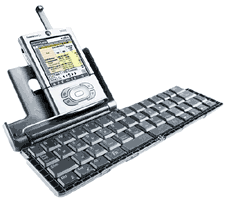 Review
of the Palm Universal Wireless Keyboard Review
of the Palm Universal Wireless Keyboard
by
Tim Root, MD
Last
updated 11-22-03
Graffiti
and block recognizer are great for jotting down lists and phone
numbers, but if you really want to get some work done, nothing beats
a full-sized keyboard. Keyboards are one of those surprisingly useful
accessories for your PDA and it amazes me that more people don't
use them.
I recently
bought the Palm Universal Wireless Keyboard for use with my IPAQ
1910, and I'd like to tell you my experiences with this nifty keyboard.
Palm
or Pocket PC?
That's right … even though it's called the
“Palm Wireless Keyboard,” the gadget also works with
your Pocket PC. The creators at ThinkOutside.com are about to release
an official Pocket PC version of the keyboard, so the latest PPC
drivers are available for download on their site.
<picture of Pocket PC
version "the Pocket PC version is about to arrive, but the
Palm version works, too">
I couldn't
wait for the Pocket PC version, so I went ahead and bought the Palm
model from my local Best Buy and so far it's worked pretty darn
well (though with a few minor idiosyncrasies).
My
first impression:
The keyboard comes packaged in one of those impregnable,
impossible-to-open blister packs, so bring something sharp and don't
cut yourself on the plastic.
<Picture of Packaging>
Upon exposure,
I found that the keyboard itself looked a little bigger than I was
expecting. While much smaller than the original Stowaway, it's a
little bigger than my mini Palm Logitech keyboard. The device also
feels a little heavier than I expected (because of the AAA batteries
needed to run the infrared LED).
<Picture of Stowaway
next to my Logitech and hp 1910>
From the outside
(closed position) the device doesn't look particularly impressive,
and for a minute I was worried that I had wasted my money on a cheap
plastic doo-dad. The plain exterior is made of that dark-gray plastic
that I associate with those ugly first-generation PalmPilots.
<dark-grey plastic pointing at
picture of Palm and keyboard, with an arrow comparing them.>
However
...
All was forgiven
after I opened up the thing and viewed the keyboard in it's working
form. The inside is sleek, with large keys, well placed cradle area,
and rubber pads that keep the keyboard from slipping while you type.
It seems to be engineered well, with no wasted space, and a sturdy-feeling
construction. Nice.
<Picture of the keyboard
open>
There is a
large platform area to rest your PDA on, with space to lay it vertically
or sideways (if your PDA supports landscape). This platform is big,
and should handle any PDA with room to spare. The closing latch
transforms into a kickstand behind the platform and supports your
PDA at a comfortable viewing angle. A metal guard rail folds forward
and keeps your PDA from slipping forward onto the keys. While necessary,
this bar has a tendency to rub against the IR stick, making it harder
to close the keyboard. Not a big problem, though.
<side picture showing both the
back kickstand and the metal rail>
Installing
the Drivers:
Because I am using the "Palm" keyboard,
I had to go online and install the Pocket PC drivers from ThinkOutside's
website. The driver installation was uneventful, creating a little
Stowaway application on my device.
After installation,
you'll find a new keyboard option available to you from the bottom
pop-up menu. To use the Stowaway, simply choose it as your input
method, and click on the 'enable IR' icon that pops up.
<screenshot of this pop-up
box>
When you are
done typing, you can re-click on the IR icon to disable the infrared.
This is important, as leaving infrared receiving on will drain your
battery.
<another screenshot showing
the little enable/disable icon>
I haven't tested the
Palm driver, yet.
How
does it feel?
The keys are surprisingly large. In fact, they are
the same size as the keys on my Sony Viao laptop. The vertical key-travel
is excellent.
<the keyboard sitting
on top om my laptop>
This is a great keyboard
for touch-typing, with appropriate bumps on the "f" and
"j" keys. The action and feel is comparable to my Sony
laptop ... if you blindfolded me, I would have a hard time guessing
between the two.
Missing keys
...
In order to fit these enormous keys into such a
small package, the designers have removed some keys and jettisoned
the number row entirely. This takes some getting used to ... especially
since important characters like the exclamation mark, parenthesis,
and the @ symbol are normally found here.
<picture of the keyboard,
labeling the number row and the two function keys>
Fortunately, all of these
symbols are obtainable, but you'll spend some time learning to use
the two function keys. It takes some time to adjust, but I think
the removal of these keys was a good space-saving decision.
Infrared
... How does it effect performance?
I was hesitant to buy an infrared keyboard as I've
had poor experiences with them in the past. IR keyboards seem prone
to transmission lag and the IR connection is often unreliable when
typing fast.
<picture of that IR keyboard?>
However, this Palm keyboard
works perfectly and so far hasn't suffered from these ailments.
I don't notice any time lag when I'm typing (and I touch-type very
fast) and it doesn't miss letters. Excellent.
One hiccup, though ...
occasionally when I pause, then suddenly type fast, a short delay
occurs before the text appears on the screen. I'm not sure if this
is the keyboard or my not-so-fast PDA (or possibly Pocket Word itself).
Fortunately, none of the typed letters are lost during these pauses,
so I can type as fast as I want without worry.
The
infrared beam
The infrared LED sits at the end of a movable plastic
arm. This flexibility allows you to accommodate many different machines.
The IR port on my IPAQ is on the upper left side, so I set my arm
at a 45-degree angle.
<IR beam at 45 degrees,
with IR arrows flying through the air>
This moving beam may
seem odd, but I prefer it to using mirrors (as found in other keyboards)
as it lets me use my PPC while it's still in its case (my case has
a cut-out for the IR port). The emitter range is pretty strong and
can transmit to my IPAQ up to 18 inches away. No, you can't type
to devices across the room ... but then again, why would you want
to?
Compatibility
Issues?
The Palm Wireless keyboard works fine on my Pocket
PC. In fact, I believe the soon-to-arrive "official Pocket
PC version" of the Stowaway keyboard will have the same hardware.
The main difference is cosmetic -- the PPC version is silver.
However, I
believe there may be small differences in how the buttons are silk-screened.
This Palm keyboard has shortcuts for "Home" "Find"
and "Star" -- these are Palm-specific shortcuts and are
not applicable to Pocket PCs. Conversely, I'll occasionally mistype
and an unlabeled function key combo will open a PocketPC-specific
application.
<Closeup
of keyboard buttons, with labeled Palm applications>
However, these issues
are minor, and do not really effect the performance of the keyboard.
I've used PDA keyboards for years, and have never used application
shortcuts, anyway. If you do use a Pocket PC, and application shortcut-key-combinations
are important to you, wait and buy the properly-labeled Pocket PC
version.
Conclusion:
I've only had the keyboard for a few days, but so
far I like it. It is easy to set up, has a sturdy design, and can
be used for touch-typing. The large rubber skid-pads and kickstand
makes this keyboard really stable on flat surfaces. The middle joint
is pretty stiff, so you could conceivably use it in your lap, though
it'll work better with a book to support the middle.
Upgradeable!
One reason I like this keyboard is that it can be
used on many different models of Pocket PCs and Palms. I don't know
about you, but I tend to upgrade handhelds about once every 18 months,
flip-flopping between Palm and Pocket PC. It's nice to know that
my keyboard will still work with my next PDA.
I like this
keyboard, and at 70 bucks, I think it is a great investment. I can't
wait to try it out on a PDA/Phone device -- a keyboard like this
would be great for typing e-mail!
PS.
I typed and edited this article using the Palm Wireless keyboard
and my HP 1910.
Pros:
- Small
- Relatively inexpensive
- Fast keyboard, touch-typable
- Big, roomy keys with good action
- Can use on current and future Palm and Pocket PCs.
Cons:
- Batteries add a little weight
- It takes a while to get use to lack of number key row.
- Occasional problems closing.
.
|



